| Plying for Knitting: The Lace and Cable Edition
I love to ply for two main reasons, it goes so fast, as fast as I wish regular spinning would go and it makes my usually not-so-even yarn look wonderful.
I've found it's good to keep the number of plies in mind when knitting particular stitches. Some just work and look better than others. In this issue's column, I'm exploring the effect of plies on stockinette, cables and lace.

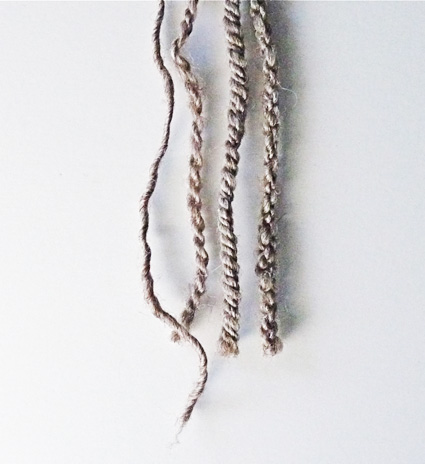 |
singles, two-ply, three-ply, cable ply
|
Plying evens out singles. No matter how hard I try, my singles are rarely uniform. If fact, it seems the harder I try the more uneven my singles get. Plying comes to my rescue every time. With two or three (or more) singles, thin and fat spots snuggle up to each other blending together and creating a more uniform yarn.
Plying makes a stronger yarn. The more plies the stronger the yarn. My hands tell me this every time I try to break a three-ply and think it will pull apart as easily as a singles.
Plied yarns are less susceptible to pilling. Think about how much surface of a singles yarn is exposed vs. the surface of a single ply in a plied yarn. The plies protect each other from abrasion so there is less pilling.
Plying is fast. Silly, maybe, but on those days I feel like my spinning project is neverending, I do a little plying and am so satisfied with the speed and beautiful yarn.
Plying can create new and combined colors. There are a crazy number of color combinations possible with plied yarn. They are only limited to the colors available and your imagination.
Plying can create interestingly textured yarn. Start with a plied yarn with singles of different diameters and let your mind wander around all of the coils, spirals, loops and cables.
Plied yarns are lighter than a singles of the same diameter. Consider a worsted-weight singles silk yarns and the same worsted weight silk as a two-ply. There is air in plied yarn, woolen or worsted spun, in the space between the plies and is the small amount the singles untwists to become a plied yarn.
I need a little tension for plying. I love a lazy kate that holds bobbins at a 45-degree angle. That is almost always enough tension for me. If my singles are particularly lively I'll move the kate further away, which gives those happy single more room to expel energy before getting plied. Still snarly? If neither of those options gives me enough tension, I will add a tensioning band. Several angled lazy kates come with the ability to add a tensioning band, the TravelKate and Anything But Lazy Kate.
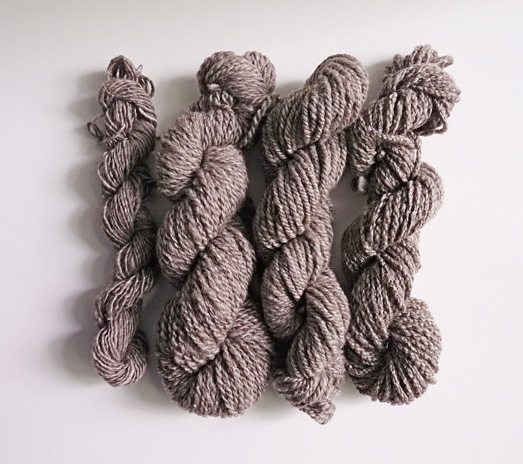 |
singles, two-ply, three-ply, cable ply
|
It took several tries to get to the best plying motion for me. I used to do a hand over hand style motion for plying, but I found I wasn't able to catch those little tiny pigtails in my singles and it was hard to get an even ply.
I switched to the hip-lock style of plying a couple years ago and it works great for me. I call it hip-lock because one of my hands is locked at my hip -- it doesn't move forward or back. For me my fiber-supply hand when I'm spinning becomes my hip-lock hand. I also make sure that each single I'm plying lies individually separated between the fingers of my hand.
My drafting hand when I spin is the hand that moves when I ply. It feeds plied yarn into the orifice at regular intervals. I regularly slide my plying hand back down the singles as they are plying -- lightly, not to disturb or fuzz up the fiber, but to feel if there are any tiny pigtails or pieces of VM that I might want to remove.
Do I count when I ply? Not usually and not consistently. I usually ply by sight. I like a little overply in most of my yarns. I know what it looks like before it slides into the orifice to get that that little extra twist, so usually I just watch. Sometimes I count to learn how a particular ply looks, then move on to just watching. Sometimes I count for the whole project.
I spun a pound of commercially prepped BFL (from PURL Chicago) all at once, worsted. I wanted all of the singles in these yarns to be created equal. In my mind it would give the samples the best base for comparison. Of course my finished plied yarns are a wide variety of sizes from DK to Bulky. I spun worsted because I wanted the yarns to be as smooth as possible to see the effect of the plies. Then I plied them to be balanced. I did count for these plied samples; balanced yarn always looks a little underdone to me.
The yarns I made to sample knit are, a singles, a two-ply, a three-ply and a cabled yarn.
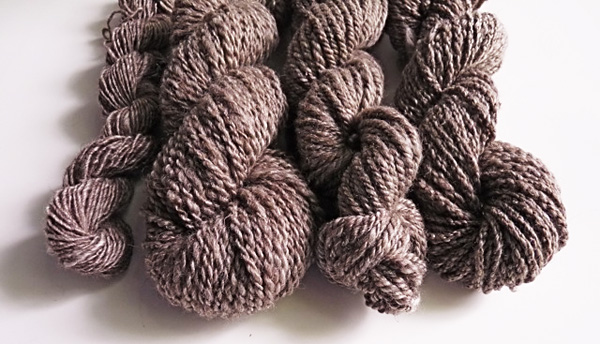 |
singles, two-ply, three-ply, cable ply
|
Each yarn was knit at a relaxed gauge, not sock tight, or shawl loose. I knit swatches in stockinette, the lace pattern is English Mesh Lace from Barbara Walker and a 6-stich cable crossed every eighth row.
I had an idea of what would happen once I started knitting my yarns, but I was surprised nonetheless. I wish you could touch these swatches and feel the relative density and the surface of each swatch.
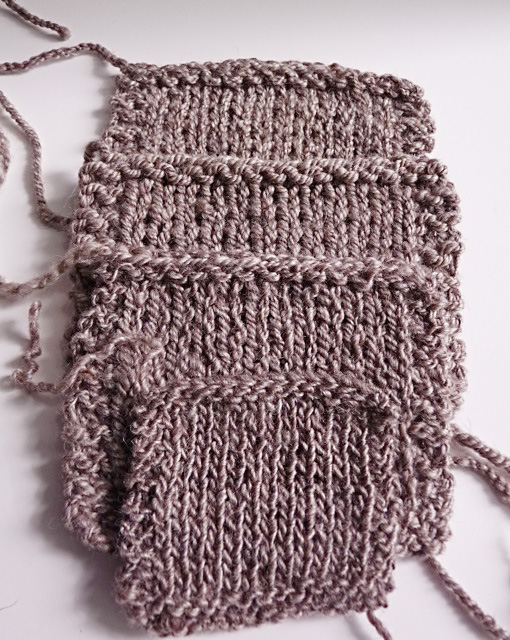 |
Sit and stay! singles, two-ply, three-ply, cable ply
|
Singles: Singles yarn forever does its own thing. The swatch biases and the surface is uneven and there is a strong vertical line in the swatch.
Two-ply: I was surprised as how textured the surface of the two-ply swatch looks. The bias is gone and the stitches have a lot of visual movement as the stitches push apart from each other.
Three-ply: The three-ply looks so smooth next to the two-ply. The stitches line up and lean it. The roundness of the yarn settles the stitches.
Cable: Cable yarns have lots of surface texture and shadows caused by the texture of the yarn. Cable yarn makes a dense stockinette. I was surprised at how much it changed the color of the fiber, it gives it a speckled look.
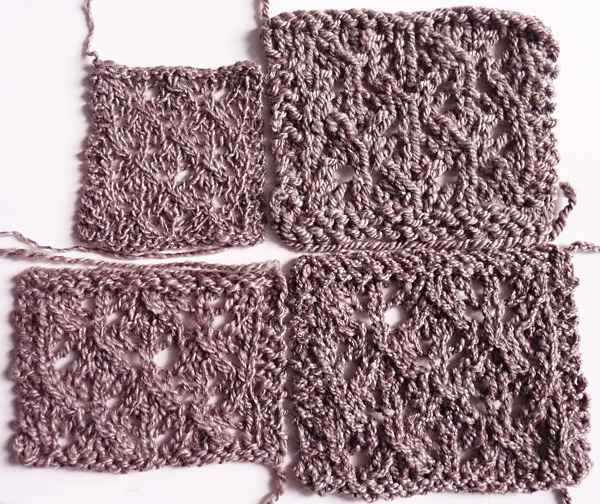 |
Open wide! top: singles, three-ply; bottom: two-ply, cable
|
Singles: Singles yarns are pliant and compliant. Blocked singles yarn stays where you put it and gives a softer look to the lace.
Two ply: Two-ply yarn is more of an oval shape than round. The visual motion in the stockinette sample work to great advantage in lace. The stitches roll away from each other, opening the lace holes. It makes a fantastic open lace yarn.
Three-ply: A three ply yarn is round and it rolls into the stitch, it wants those yarn overs to close. It was very much more interested in making the decreases pop. A firm blocking yielded a not so very lacey lace.
Cable: The cable yarn fought me every step of the way with lace. It wasn't even happy with knitting the yarn overs, much less opening itself for the lace pattern. I blocked it pretty intensely and as soon as I pulled the pins out when it was dry, it snapped back to what you see. Cable makes a crabby lace yarn.
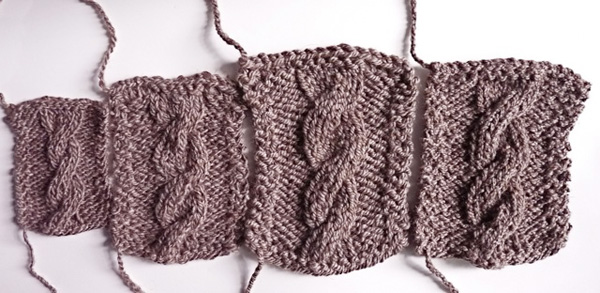 |
Twisting! singles, two-ply, three-ply, cable ply
|
Singles: I found a singles cable limp and soft looking, not what I want in a cable.
Two-ply: The two-ply cable is better than the singles cable. There are times I would like the extra visual motion the two-ply give the cable, an extra undulation in the cable.
Three-ply: Attention! This cable stands up. The rolling in that make a 3-ply kind of a crappy lace yarn makes it a fab yarn for cables. The stitches press together and stand up. Three-ply is the perfect yarn for a cable.
Cable: The cable yarn is round and rolls in but the surface texture of the yarn adds texture to texture. The cable looks dense and meaty. A whole garment of cable cables would be very heavy.
 |
Pop up! singles, two-ply, three-ply, cable ply
|
Of course, once I get started sampling I can't stop easily. I was curious about what happens with variegated yarns plus plies so I did a quickie spin and knit with just singles, two-ply and two-ply with Blue Moon Fiber Arts BFL in the Rocktober colorway. I randomly plied not controlling the colors at all.
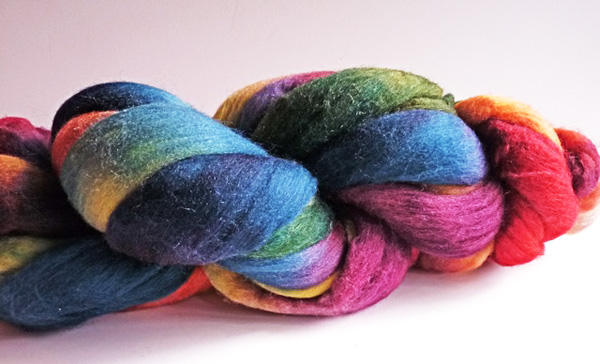 |
Rocktober! BFL from Blue Moon Fiber Arts
|
Here are the results of that fun:
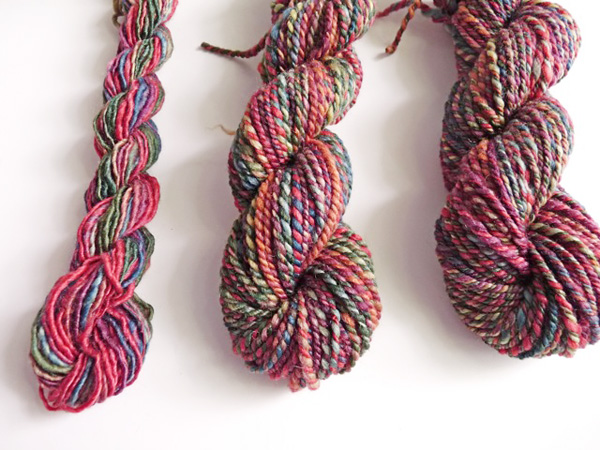 |
Color blending, singles, two-ply, three-ply
|
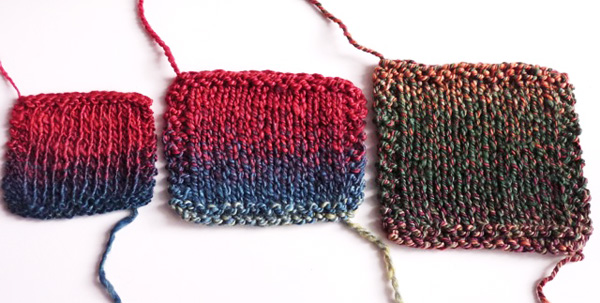 |
Stockinette: Smooth color, singles, two-ply, three-ply
|
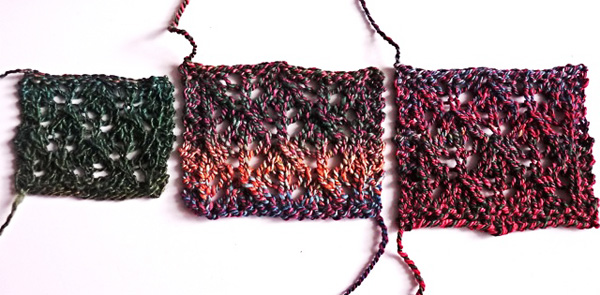 |
Lace: Open color, singles, two-ply, three-ply
|
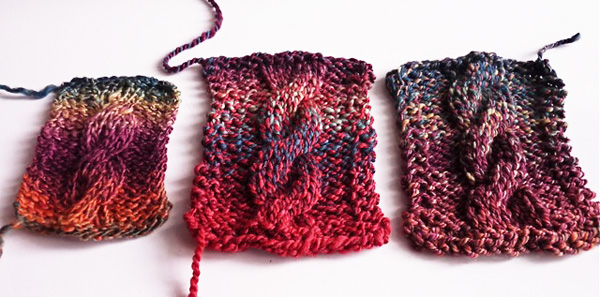 |
Cables: Twisty color, singles, two-ply, three-ply
|
Of course this leads me to wanting to experiment with controlling the color in the spinning and plying before I knit. Now I am curious about plying and knitting colorwork. But, that's for another column.
|

